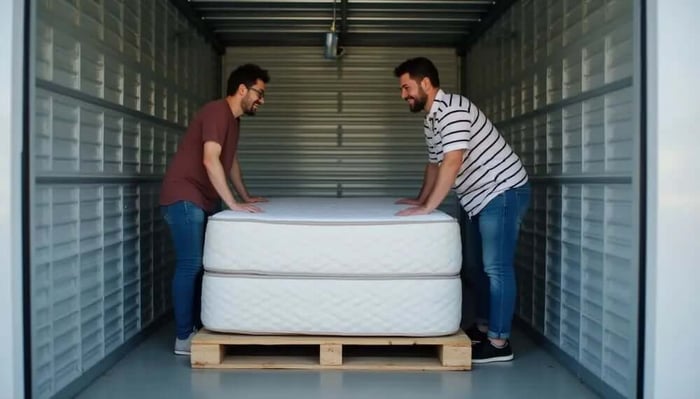Table of Contents
- Declutter & Inventory Your Clothing
- Clean & Fully Dry Your Clothing
- Purchase Your Clothing Storage Containers
- Other Clothing Storage Essentials to Consider
- Pack Your Clothing Storage Containers
- Choosing the Right Storage Unit for Clothing
- Check Your Storage Unit Periodically
- Rent Clothing Storage to Get More Space
- FAQs
There are many times when you need to reclaim extra space in your closets, dressers, and bedroom. Knowing how to store clothes in a storage unit is key. Whether you need to pack away seasonal clothing or are looking to free up a closet, we’ve got you covered with our comprehensive guide.
We’ll teach you the ways of storing clothes in storage, as well as how to hang clothes in a storage unit and best practices for clothing preservation. (and more!)
Declutter & Inventory Your Clothing
The first step in "how to store clothes in a storage unit" is sorting through what you own. Begin by decluttering. You do not need to store everything. Only keep garments that you genuinely intend to reuse. Donate anything that no longer fits or is out of style. You can also consider donating items that are stained or torn.
Pro Tip: If you haven’t worn something in six months to a year - and it’s not sentimental or an occasion item (think a tuxedo!) - it's time to donate the item.
Once you’re left with the things you’re going to keep, create an inventory list. This will help you track what’s going into your storage unit - and what boxes or containers you’re going to be keeping it in.
To make packing and retrieval easier, group your items according to:
Season: Summer, fall, winter, spring - very basic but very practical
Activity: Pack your items based on the activity you’d use them for - ski gear, swimwear, camping and hiking, etc
Type of Item: Another basic way to pack your items - Group them by type of item: t-shirts, sweaters, bottoms, outerwear. Pair this with grouping by season, and you’ll be more than organized
Age: If you’re storing children’s or baby clothes, either for future additions or sentimental reasons, store by age bracket (infant, toddler, children’s sizes, juniors, etc.)
Clean & Fully Dry Your Clothing
This is essential for storing clothes in storage. Always wash and thoroughly dry your clothes before storing!
Why? Residual oils, sweat, or dirt can lead to mold, mildew, or permanent stains and odors during storage.
Purchase Your Clothing Storage Containers
Opt for the best way to store clothes in a storage unit! Here are some recommendations for the proper storage containers and storage boxes to use:
Airtight Plastic Containers: These bins, with snap-on lids, will help to shield against moisture, pests, and dust
Clear Plastic Bins: Clear bins allow you to identify contents quickly
Wardrobe Boxes: Wardrobe boxes are excellent when moving, as you can easily transport hanging clothes. The only downside (see below) is that most of these are cardboard - and cardboard is not your friend when it comes to storing clothes
Clothing Rack with Vinyl Cover: If you’re renting a climate-controlled storage unit and need to hang your clothing, we recommend purchasing a clothing rack and covering it with a clear rack cover. You’ll be able to see what you’re storing, and your items will be protected from dust
Vacuum-Sealed Bags: If you’re storing bulky sweaters, snowpants, or puffy jackets, vacuum packing is a great option. These bags will help you save space and keep your items safe
Garment Bags: If you’re going to be hanging clothes, these are also a must! Make sure that the bags are of good quality and made of breathable fabric
Pro Tip: Avoid storing your clothing in a cardboard box, especially if you’re not renting a climate-controlled unit. These boxes are more prone to attracting pests, trapping moisture, and damaging your fabric. Cardboard boxes can also absorb nearby odors, and these transfer to your clothes.
Other Clothing Storage Essentials to Consider
While choosing the proper storage containers is key, there are also other items you can purchase for long-term clothing storage, including:
Cedar Chips: To further prevent pests and mildew, consider adding cedar chips or cedar blocks to your containers
Dryer Sheets: Add a few dryer sheets to your containers to help your clothes smell fresh
Moisture Absorbers: Consider adding silica gel packets to your clothing storage. If humidity is a concern in your area, we highly recommend it
Hangers: You’ll need these on hand if you plan to hang any clothes in your storage unit
Acid-Free Tissue Paper: Use this paper between delicate items, such as lace and silks
Pro Tip: Skip the mothballs. While they serve a purpose, we do not recommend them because mothball fumes can stick to fabric and give it a foul odor.
Pack Your Clothing Storage Containers
Now it’s time to pack your clothing! To save space, roll your clothes rather than fold them. This will help to minimize creases, too.
Place your heavier items at the bottom of your storage bins, with lighter items on the top. Once all of your items are in a plastic bin, label the outside. Make sure your label matches your initial inventory list. You’ll want to refer to that at a later date.
If you’re vacuum sealing items, make sure you’re taking into consideration fabric. Certain fabrics, like wool, silk, and certain knits, can get damaged easily. Plus, certain fabrics need to breathe.
So, remember to:
Roll your clothes
Place heavier items on the bottom of each storage container
Label each clothing storage container
Ensure that your initial inventory list matches the labels on every bin
Choosing the Right Storage Unit for Clothing
You should store your clothing in a climate-controlled storage unit. This is optimal for fabric preservation and avoiding damaging heat and humidity. If you plan to store clothing items in long-term storage, this type of unit is precisely what you need.
If climate control is unavailable in your area, consider touring a storage facility near you to find a unit that’s in the shade or receives the least amount of sun exposure throughout the day.
Check Your Storage Unit Periodically
Every six to twelve months, you want to check on your clothes. Open the bins to air them out and check for any signs of pests or moisture. The earlier you detect a problem, the less likely you’ll see any long-term damage.
If you’re storing seasonal items or are renting for the short-term, this step won’t be necessary.
Rent Clothing Storage to Get More Space
Now that you know how to store clothes in a storage unit, it's time to rent one!
If you’re decluttering your home and want to keep your clothing in good condition, don’t throw your apparel in an attic, basement, or garage. Storage Star has storage locations nationwide and can provide you with a clean, secure, and affordable storage solution that will protect your delicate clothing.
If you’re ready to free up closet space and get a self-storage unit, you can rent your space online today! Quickly locate a Storage Star storage facility near you and rent now. We’ve got the storage space for any type of clothing, freeing up more space in your closet for other things.
FAQs
What is the best way to store clothes in a storage unit?
The best way is to:
- Clean and dry clothes before packing
- Use airtight bins or vacuum-sealed bags
- Store in a climate-controlled self-storage unit
Can you hang clothes in a storage unit?
Yes! Storage units do not come equipped with racks, though, so you will need to purchase a garment rack. If you're hanging clothes in a storage unit, ideally in a climate-controlled environment, cover the garment rack with a vinyl cover.
How do you keep clothes from getting moldy in storage?
You want to wash and dry your clothes completely before you store them. Use moisture absorbers, like silica gel, in your unit. Also, rent a climate-controlled unit, as it will reduce humidity and associated damage.
Is it OK to store clothes in cardboard boxes?
No. It is not recommended to store clothes in cardboard boxes. Cardboard is prone to trapping moisture, attracting pests, and absorbing odors. We recommend using durable plastic storage containers.
How long can clothes stay in a storage unit?
Indefinitely, if the clothes are stored properly and in the right condition. Using climate-controlled storage and sealed plastic containers will help keep your clothes safe in long-term storage.
How do I keep my clothes smelling fresh in a storage unit?
You can keep your clothes smelling fresh by using:
- Breathable garment bags
- Cedar chips or blocks
- Dryer sheets
What clothes should not be vacuum sealed?
Do not put the following fabrics in vacuum-sealed bags:
- Silk
- Wool
- Certain knits
These fabrics must breathe and can lose their shape when compressed





